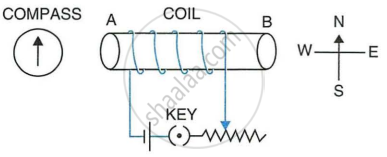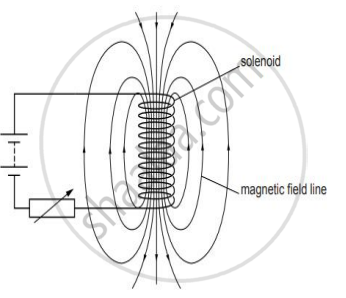Advertisements
Advertisements
Question
Ansari Sir was demonstrating an experiment in his class with the setup as shown in the figure below.

A magnet is attached to a spring. The magnet can go in and out of the stationary coil. He lifted the Magnet and released it to make it oscillate through the coil.
Based on your understanding of the phenomenon, answer the following question.
Is there any difference in the observations in the galvanometer when the Magnet swings in and then out of the stationary coil? Justify your answer.
Solution
- When the magnet moves into the coil, the ammeter shows a momentary deflection towards one side saying left.
- When the magnet moves out of the coil, the ammeter shows a momentary deflection now towards right.
- This is due to changing magnetic field/flux associated with the coil as the magnet moves in and out.
- Alternatively, the flux increases when the magnet goes in and it decreases when the magnet goes out.
APPEARS IN
RELATED QUESTIONS
Why does a current carrying, freely suspended solenoid rest along a particular direction?
The following diagram shows a spiral coil wound on a hollow carboard tube AB. A magnetic compass is placed close to it. Current is switched on by closing the key.
- What will be the polarity at the ends A and B?
- How will the compass needle be affected? Give reason.

State two ways by which the magnetic field due to a current carrying solenoid can be made stronger.
What effect will there be on a magnetic compass when it is brought near a current carrying solenoid?
A current carrying solenoid when freely suspended, it always rests in ______ direction.
For a current in a long straight solenoid, N-pole and S-pole are created at the two ends. Among the following statements, the incorrect statement is ____________.
A circuit contains a battery, a variable resistor and a solenoid. The figure below shows the magnetic field pattern produced by the current in the solenoid.

- State how the magnetic field pattern indicates regions where the magnetic field is stronger.
- What happens to the magnetic field when the current in the circuit is reversed?
Refer to the image below and state how the magnetic field pattern indicates regions where the magnetic field is stronger outside the magnet. What happens to the magnetic field when the current in the circuit is reversed?

Differentiate between a circular coil and a solenoid.
Current is flowing through a coil as shown in the figure. Which one of the given figures will correctly depict the magnetic polarity and the direction of the lines of force along the axis of the coil?

